start Ram 1500 2020 Owner's Manual
[x] Cancel search | Manufacturer: RAM, Model Year: 2020, Model line: 1500, Model: Ram 1500 2020Pages: 674, PDF Size: 32.69 MB
Page 482 of 674

480 IN CASE OF EMERGENCY
(Continued)
Two-Wheel Drive Models
The manufacturer recommends towing your vehicle with all
four wheels OFF the ground using a flatbed.
If flatbed equipment is not available, and the transmission is
operable, the vehicle may be towed (with rear wheels on the
ground) under the following conditions:
• The transmission must be in NEUTRAL.
NOTE:
Refer to “Manual Park Release” in this section for instruc -
tions on shifting the transmission to NEUTRAL when the
engine is OFF.
• The towing speed must not exceed 30 mph (48 km/h).
• The towing distance must not exceed 30 miles (48 km).
If the transmission is not operable, or the vehicle must be
towed faster than 30 mph (48 km/h) or farther than 30 miles (48 km), tow with the rear wheels OFF the ground. Accept -
able methods are to tow the vehicle on a flatbed, or with the
front wheels raised and the rear wheels on a towing dolly, or
(when using a suitable steering wheel stabilizer to hold the
front wheels in the straight position) with the rear wheels
raised and the front wheels on the ground.
Four-Wheel Drive Models
The manufacturer recommends towing with all wheels OFF
the ground. Acceptable methods are to tow the vehicle on a
flatbed or with one end of vehicle raised and the opposite
end on a towing dolly.
If flatbed equipment is not available, and the transfer case is
operable, the vehicle may be towed (in the forward direction,
with ALL wheels on the ground), IF the transfer case is in
NEUTRAL (N) and the transmission is in PARK.
Refer to “Recreational Towing” in “Starting And Operating”
for further information and detailed instructions. CAUTION!
Towing this vehicle in violation of the above
requirements can cause severe transmission damage.
Damage from improper towing is not covered under the
New Vehicle Limited Warranty.
CAUTION!
• Front or rear wheel lifts must not be used (if the remaining wheels are on the ground). Internal damage
to the transmission or transfer case will occur if a front
or rear wheel lift is used when towing.
2020_DT_1500_OM_US.book Page 480
Page 487 of 674
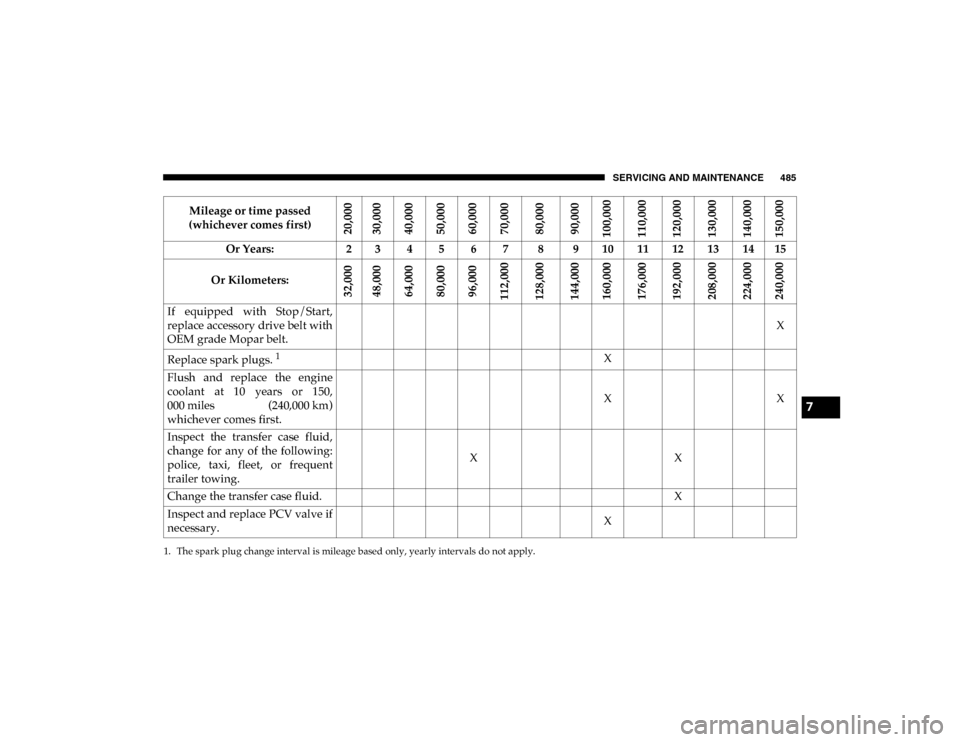
SERVICING AND MAINTENANCE 485
If equipped with Stop/Start,
replace accessory drive belt with
OEM grade Mopar belt.X
Replace spark plugs.
1X
Flush and replace the engine
coolant at 10 years or 150,
000 miles (240,000 km)
whichever comes first. X
X
Inspect the transfer case fluid,
change for any of the following:
police, taxi, fleet, or frequent
trailer towing. X
X
Change the transfer case fluid. X
Inspect and replace PCV valve if
necessary. X
1. The spark plug change interval is mileage based only, yearly intervals do not apply.
Mileage or time passed
(whichever comes first)
20,000
30,000
40,00050,00060,00070,000
80,00090,000
100,000
110,000120,000130,000140,000150,000
Or Years: 2 3 4 5 6 7 8 9 10 11 12 13 14 15
Or Kilometers:
32,000 48,000
64,00080,00096,000
112,000
128,000144,000160,000
176,000192,000208,000224,000240,000
7
2020_DT_1500_OM_US.book Page 485
Page 489 of 674
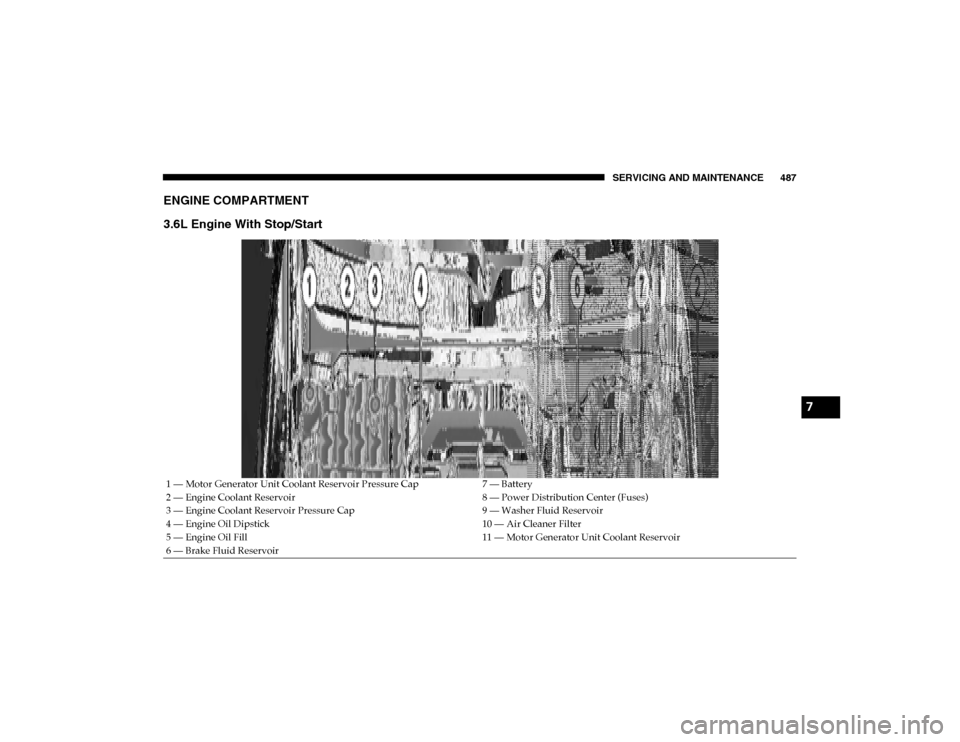
SERVICING AND MAINTENANCE 487
ENGINE COMPARTMENT
3.6L Engine With Stop/Start
1 — Motor Generator Unit Coolant Reservoir Pressure Cap7 — Battery
2 — Engine Coolant Reservoir 8 — Power Distribution Center (Fuses)
3 — Engine Coolant Reservoir Pressure Cap 9 — Washer Fluid Reservoir
4 — Engine Oil Dipstick 10 — Air Cleaner Filter
5 — Engine Oil Fill 11 — Motor Generator Unit Coolant Reservoir
6 — Brake Fluid Reservoir
7
2020_DT_1500_OM_US.book Page 487
Page 490 of 674
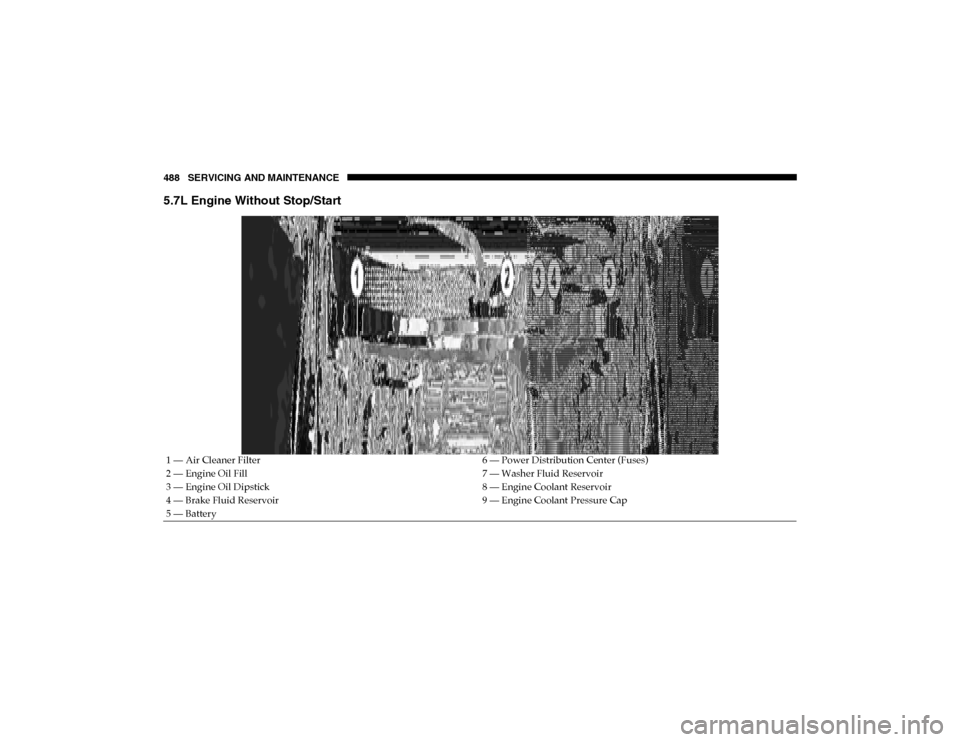
488 SERVICING AND MAINTENANCE
5.7L Engine Without Stop/Start
1 — Air Cleaner Filter6 — Power Distribution Center (Fuses)
2 — Engine Oil Fill 7 — Washer Fluid Reservoir
3 — Engine Oil Dipstick 8 — Engine Coolant Reservoir
4 — Brake Fluid Reservoir 9 — Engine Coolant Pressure Cap
5 — Battery
2020_DT_1500_OM_US.book Page 488
Page 491 of 674
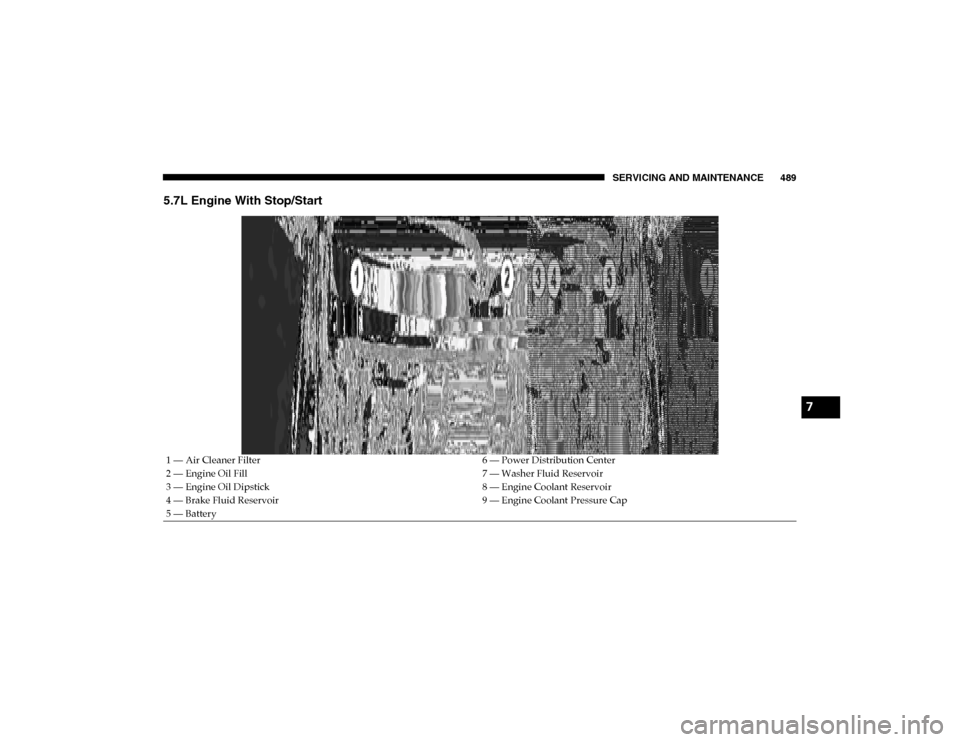
SERVICING AND MAINTENANCE 489
5.7L Engine With Stop/Start
1 — Air Cleaner Filter6 — Power Distribution Center
2 — Engine Oil Fill 7 — Washer Fluid Reservoir
3 — Engine Oil Dipstick 8 — Engine Coolant Reservoir
4 — Brake Fluid Reservoir 9 — Engine Coolant Pressure Cap
5 — Battery
7
2020_DT_1500_OM_US.book Page 489
Page 493 of 674
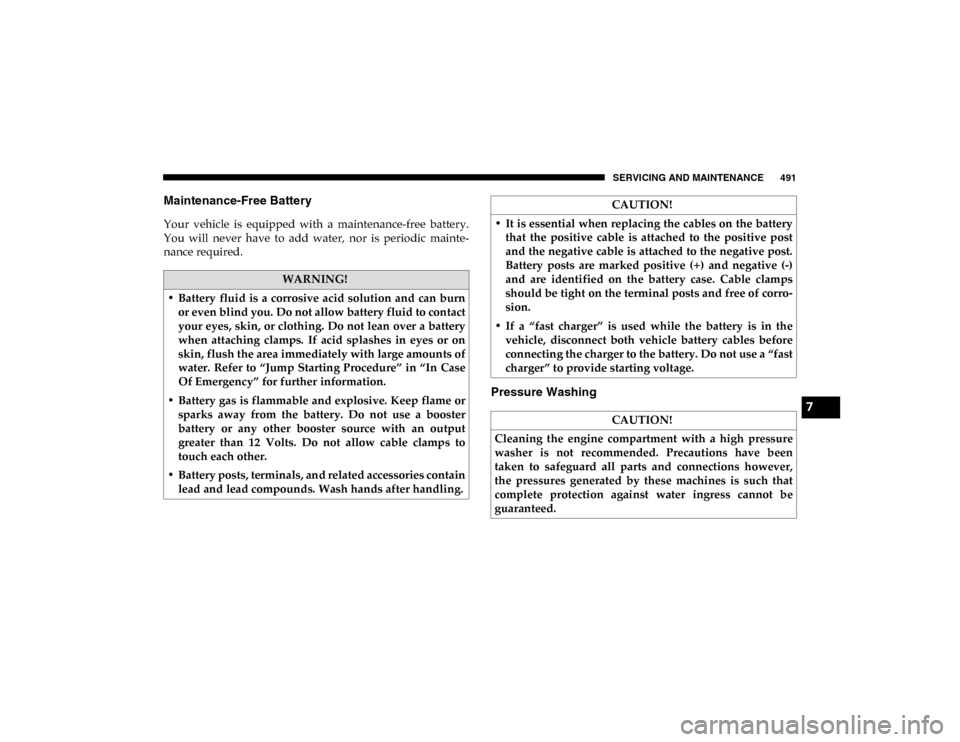
SERVICING AND MAINTENANCE 491
Maintenance-Free Battery
Your vehicle is equipped with a maintenance-free battery.
You will never have to add water, nor is periodic mainte-
nance required.
Pressure Washing
WARNING!
• Battery fluid is a corrosive acid solution and can burn or even blind you. Do not allow battery fluid to contact
your eyes, skin, or clothing. Do not lean over a battery
when attaching clamps. If acid splashes in eyes or on
skin, flush the area immediately with large amounts of
water. Refer to “Jump Starting Procedure” in “In Case
Of Emergency” for further information.
• Battery gas is flammable and explosive. Keep flame or sparks away from the battery. Do not use a booster
battery or any other booster source with an output
greater than 12 Volts. Do not allow cable clamps to
touch each other.
• Battery posts, terminals, and related accessories contain lead and lead compounds. Wash hands after handling.
CAUTION!
• It is essential when replacing the cables on the battery that the positive cable is attached to the positive post
and the negative cable is attached to the negative post.
Battery posts are marked positive (+) and negative (-)
and are identified on the battery case. Cable clamps
should be tight on the terminal posts and free of corro -
sion.
• If a “fast charger” is used while the battery is in the vehicle, disconnect both vehicle battery cables before
connecting the charger to the battery. Do not use a “fast
charger” to provide starting voltage.
CAUTION!
Cleaning the engine compartment with a high pressure
washer is not recommended. Precautions have been
taken to safeguard all parts and connections however,
the pressures generated by these machines is such that
complete protection against water ingress cannot be
guaranteed.
7
2020_DT_1500_OM_US.book Page 491
Page 495 of 674
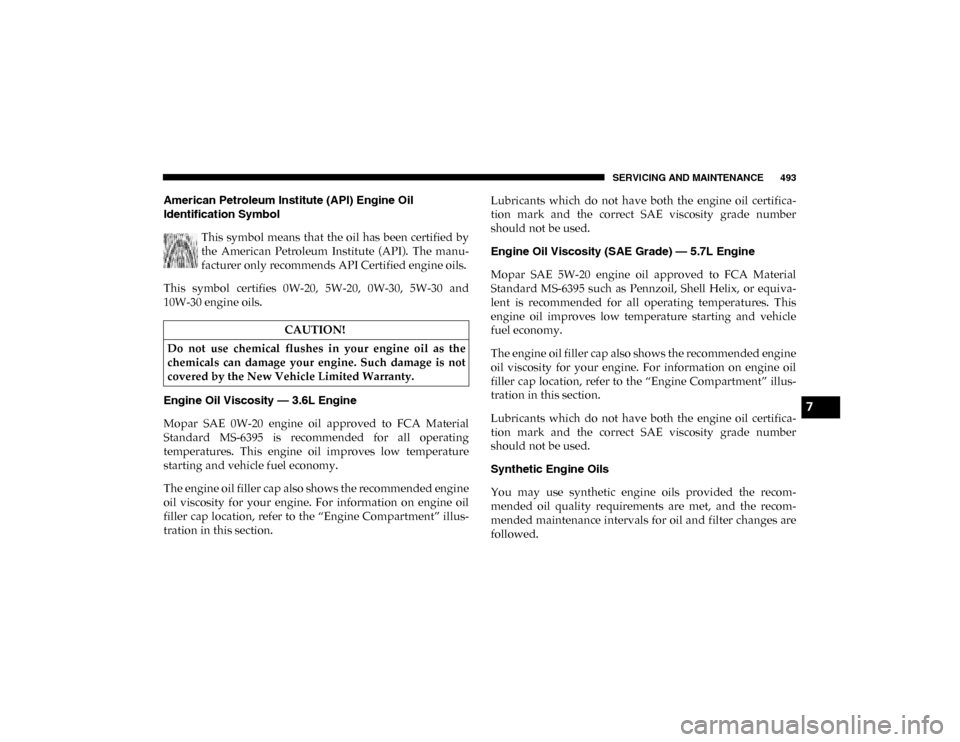
SERVICING AND MAINTENANCE 493
American Petroleum Institute (API) Engine Oil
Identification Symbol This symbol means that the oil has been certified by
the American Petroleum Institute (API). The manu -
facturer only recommends API Certified engine oils.
This symbol certifies 0W-20, 5W-20, 0W-30, 5W-30 and
10W-30 engine oils.
Engine Oil Viscosity — 3.6L Engine
Mopar SAE 0W-20 engine oil approved to FCA Material
Standard MS-6395 is recommended for all operating
temperatures. This engine oil improves low temperature
starting and vehicle fuel economy.
The engine oil filler cap also shows the recommended engine
oil viscosity for your engine. For information on engine oil
filler cap location, refer to the “Engine Compartment” illus -
tration in this section. Lubricants which do not have both the engine oil certifica
-
tion mark and the correct SAE viscosity grade number
should not be used.
Engine Oil Viscosity (SAE Grade) — 5.7L Engine
Mopar SAE 5W-20 engine oil approved to FCA Material
Standard MS-6395 such as Pennzoil, Shell Helix, or equiva -
lent is recommended for all operating temperatures. This
engine oil improves low temperature starting and vehicle
fuel economy.
The engine oil filler cap also shows the recommended engine
oil viscosity for your engine. For information on engine oil
filler cap location, refer to the “Engine Compartment” illus -
tration in this section.
Lubricants which do not have both the engine oil certifica -
tion mark and the correct SAE viscosity grade number
should not be used.
Synthetic Engine Oils
You may use synthetic engine oils provided the recom -
mended oil quality requirements are met, and the recom -
mended maintenance intervals for oil and filter changes are
followed.
CAUTION!
Do not use chemical flushes in your engine oil as the
chemicals can damage your engine. Such damage is not
covered by the New Vehicle Limited Warranty.
7
2020_DT_1500_OM_US.book Page 493
Page 496 of 674
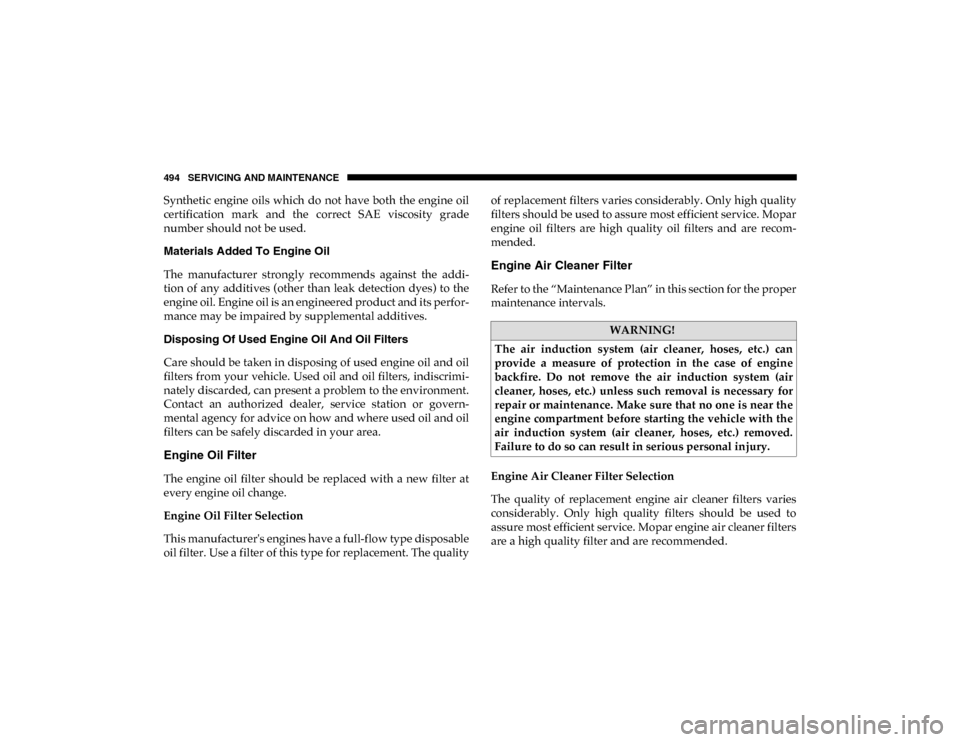
494 SERVICING AND MAINTENANCE
Synthetic engine oils which do not have both the engine oil
certification mark and the correct SAE viscosity grade
number should not be used.
Materials Added To Engine Oil
The manufacturer strongly recommends against the addi-
tion of any additives (other than leak detection dyes) to the
engine oil. Engine oil is an engineered product and its perfor -
mance may be impaired by supplemental additives.
Disposing Of Used Engine Oil And Oil Filters
Care should be taken in disposing of used engine oil and oil
filters from your vehicle. Used oil and oil filters, indiscrimi -
nately discarded, can present a problem to the environment.
Contact an authorized dealer, service station or govern -
mental agency for advice on how and where used oil and oil
filters can be safely discarded in your area.
Engine Oil Filter
The engine oil filter should be replaced with a new filter at
every engine oil change.
Engine Oil Filter Selection
This manufacturer's engines have a full-flow type disposable
oil filter. Use a filter of this type for replacement. The quality of replacement filters varies considerably. Only high quality
filters should be used to assure most efficient service. Mopar
engine oil filters are high quality oil filters and are recom
-
mended.
Engine Air Cleaner Filter
Refer to the “Maintenance Plan” in this section for the proper
maintenance intervals.
Engine Air Cleaner Filter Selection
The quality of replacement engine air cleaner filters varies
considerably. Only high quality filters should be used to
assure most efficient service. Mopar engine air cleaner filters
are a high quality filter and are recommended.
WARNING!
The air induction system (air cleaner, hoses, etc.) can
provide a measure of protection in the case of engine
backfire. Do not remove the air induction system (air
cleaner, hoses, etc.) unless such removal is necessary for
repair or maintenance. Make sure that no one is near the
engine compartment before starting the vehicle with the
air induction system (air cleaner, hoses, etc.) removed.
Failure to do so can result in serious personal injury.
2020_DT_1500_OM_US.book Page 494
Page 498 of 674

496 SERVICING AND MAINTENANCE
3. Remove the air cleaner filter element from the housingassembly.
Air Cleaner Filter Engine Air Cleaner Filter Installation
NOTE:
Inspect and clean the housing if dirt or debris is present
before replacing the air filter element.
1. Install the air cleaner filter element into the housing
assembly with the air cleaner filter inspection surface
facing downward.
2. Install the air cleaner cover onto the housing assembly.
3. Tighten the fasteners (six) on the air cleaner filter assembly
Air Conditioner Maintenance
For best possible performance, your air conditioner should
be checked and serviced by an authorized dealer at the start
of each warm season. This service should include cleaning of
the condenser fins and a performance test. Drive belt tension
should also be checked at this time.1 — Air Cleaner Cover
2 — Air Cleaner Filter
2020_DT_1500_OM_US.book Page 496
Page 503 of 674

SERVICING AND MAINTENANCE 501
NOTE:
Ensure the glove compartment door hinges and glove
compartment travel stops are fully engaged.
10. Reattach the glove compartment tension tether byinserting the tether clip in the glove compartment and
sliding the clip away from the face of the glove compart -
ment door.
Accessory Drive Belt Inspection
When inspecting accessory drive belts, small cracks that run
across the ribbed surface of a belt from rib to rib, are consid -
ered normal. These are not a reason to replace the belt.
However, cracks running along a rib (not across) are not
normal. Any belt with cracks running along a rib must be
replaced. Also have the belt replaced if it has excessive wear,
frayed cords or severe glazing.
Accessory Belt (Serpentine Belt)
WARNING!
• Do not attempt to inspect an accessory drive belt with vehicle running.
• When working near the radiator cooling fan, discon -
nect the fan motor lead. The fan is temperature
controlled and can start at any time regardless of igni -
tion mode. You could be injured by the moving fan
blades.
• You can be badly injured working on or around a motor vehicle. Only do service work for which you have the
knowledge and the proper equipment. If you have any
doubt about your ability to perform a service job, take
your vehicle to a competent mechanic.
7
2020_DT_1500_OM_US.book Page 501